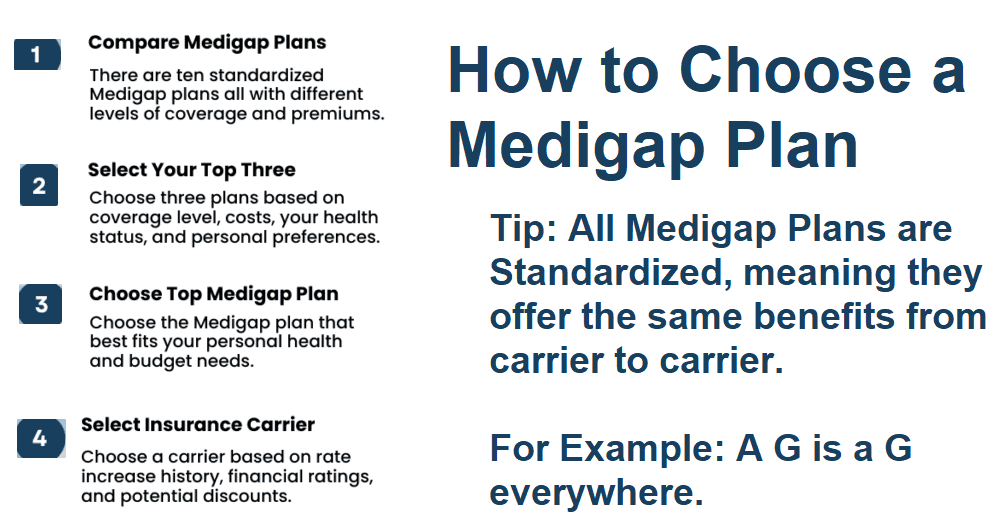A Medicare Supplement, also known as a Medigap Plan, is a form of health insurance provided by private insurers to fill in the gaps left by Medicare. These plans have been available since the inception of Medicare, but they were officially regulated by the Omnibus Reconciliation Act of 1980.
Think of a Medicare Supplement as an additional card that attaches to your Original Medicare coverage. It covers the expenses that Medicare would otherwise require you to pay out of pocket, such as coinsurance, copayments, and deductibles. When you receive medically-approved services, you are responsible for paying these costs.
If you have a Supplement policy, Medicare will first cover its portion of your medical expenses. Then, your policy will step in and cover its portion, which typically includes the remaining balance of your bill. However, the exact coverage will depend on the specific plan you choose from the available options.

Explore the ten standard Medicare Supplements available.
In 1990, Medicare established guidelines that every Medicare Supplement must adhere to. These guidelines standardized all plans, and each plan is designated by a letter. Medicare refers to them as plans, including Medigap Plan A, Plan B, Plan C, Plan D, Plan F, Plan G, Plan K, Plan L, Plan M, and Plan N. Regardless of the company, each of these lettered policies offers the same set of benefits.
The primary difference between supplements with the same letter lies in the monthly premium. Therefore, it is advisable to compare rates from multiple insurance carriers to find the best option.
Plans F, G, and N are the ones that receive the highest number of requests.
Medicare Supplement Plan F
Medicare Supplement Plan F stands out as a highly sought-after option among the various Supplements available nationwide. It covers the entire 100% of the expenses that Medicare would typically charge you. Consequently, with Medicare Supplement Plan F, you won’t be burdened with any deductibles or copays. Rest assured, Plan F will take care of your entire share of the costs.
Medicare Supplement Plan G
Medicare Supplement Plan G has experienced a surge in popularity over the past few years. It operates similarly to Plan F, with the exception of the Part B deductible. Under this plan, you are responsible for covering the Part B deductible annually, and once that is met, it covers all other expenses. As of 2024, the Part B deductible amounts to $240 per year. Frequently, you can discover Medicare Supplement Plan G premiums that exceed the savings of $240 per year. This implies that in the long term, you will be in a better financial position.
Medicare Supplement Plan N
Medicare Supplement Plan N, introduced in 2010, is a relatively new addition to the Medigap plans. Compared to Plan F or Plan G, Plan N generally offers lower premiums. However, it does require more cost-sharing on your part. Each time you visit a doctor, you will be responsible for a copay of up to $20. Additionally, for an emergency room visit, you will owe copays of up to $50.
Another aspect to consider is the excess charges. Some doctors may bill an additional 15% above Medicare’s rate, known as an Excess Charge. With Plan F or Plan G, these charges are taken care of for you. However, with Plan N, you will be responsible for paying the excess charge yourself. For more information, please refer to the glossary below.
Medicare or your Medicare Supplement does not provide coverage for certain items, including:
Medicare Supplement Plans do not cover certain expenses that are not included in the original Medicare coverage. These plans are designed to fill in the gaps left by Medicare, but they have limitations. It is important to understand what is not covered by Medicare Supplement Plans to avoid any surprises.
1. Regular dental, vision, and hearing check-ups
2. Hearing aids
3. Eyeglasses or contact lenses
4. Long-term care or custodial care
5. Retail prescription drugs.
Please note that these specific services and items are not included in the coverage provided by Medicare or your Medicare Supplement.
 Choosing a Medicare Supplement
Choosing a Medicare Supplement
It is important to note that Medigap plans follow a standardized format, ensuring that you have a clear understanding of the benefits you are acquiring. Additionally, all Medicare Supplement plans come with a guarantee of renewability, eliminating the need for annual reapplication. However, before selecting your Supplement, it is advisable to familiarize yourself with various factors pertaining to each insurance carrier.
Medicare Supplement Premiums – What exactly is a Medicare Supplement premium? Is it the monthly fee that you pay to the insurance company for your Medicare Supplement coverage? Discover the premium rates offered by each insurance carrier. Are they providing a low premium option? How does it compare to other Medigap insurance companies in your area?
Rate Trend Analysis – It is common for most policies to experience an annual rate increase in order to keep up with medical inflation. Have you looked into the rate increases that the insurance carrier you are considering has implemented over the past three years? Are these rate increases reasonable or significantly higher compared to their competitors?
Financial Stability Ratings – Various ratings companies thoroughly assess the financial stability of each insurance carrier. These companies provide reports or grades that evaluate the fiscal health of the insurer. Consult your agent to find out the A.M. Best and Weiss Ratings for each carrier. Consider this valuable information when making your final decision.
Glossary of Terms
The terminology surrounding Medicare Supplements can be quite challenging to understand. Let’s take a closer look at the benefits outlined by Medicare.
1. Medicare Part A coinsurance: All Medigap plans include this benefit, which covers the costly daily hospital copays that you start accumulating after your 60th day in the hospital.
2. Medicare Part B coinsurance or copayment: This benefit is also covered by every Supplement plan and is one of the most crucial benefits. Since Medicare only covers 80% of your Part B outpatient expenses, this benefit pays the remaining 20% on your behalf. This can be particularly important for expensive treatments like cancer treatments or dialysis.
3. Blood (First 3 pints): All plans provide coverage for the first 3 pints of blood in a blood transfusion. Medicare only covers the 4th pint and beyond. Considering the high cost of blood, this benefit is highly valuable.
4. Part A Hospice care coinsurance or copayment: Supplements cover the portions of hospice care that Medicare doesn’t, ensuring that you usually have no out-of-pocket costs for hospice care.
5. Skilled Nursing Facility coinsurance: Medicare allows for 100 days of skilled nursing facility (SNF) care after a hospital stay when nursing care is required for recovery. However, Medicare only covers the first 20 days. A policy with SNF coverage will take care of the remaining 80 days.
6. Medicare Part A deductible: The Part A deductible for 2024 is $1,632. If you have multiple inpatient hospital stays that are more than 60 days apart, you may need to pay this deductible more than once in a year.
7. Medicare Part B deductible: In 2024, the Part B deductible amounts to $240 per year. You will be responsible for paying this deductible once annually for services like doctor’s visits, lab work, or physical therapy, unless your Medicare Supplement plan covers it.
8. Medicare Part B excess charges: Medicare providers have the option to either accept Medicare’s assigned rates for each service or charge an excess fee, which can be up to 15% above the assigned rate. This charge can be significant for services like diagnostic imaging or surgery.
9. Foreign travel Medicare, being a health insurance program exclusive to the United States, does not provide coverage for emergencies that occur outside the country. However, certain Medicare Supplements do offer a foreign travel benefit, which covers 80% of your expenses up to $50,000 after a deductible.
Takeaways
Medicare beneficiaries highly favor Plans F, G, and N. Nevertheless, only individuals who qualified for Medicare prior to January 1, 2020, can access Plan F. The monthly premiums for Medigap plans differ based on various factors such as age, zip code, gender, tobacco use, and more. While you have the flexibility to apply for a Medigap plan at any point in the year, if you are beyond your Medigap Open Enrollment period, you may need to undergo underwriting, depending on your state regulations.
 Mario Arce
Mario Arce
I have been working with Medicare clients since 2016. I serve California members in San Bernardino & Riverside county.


